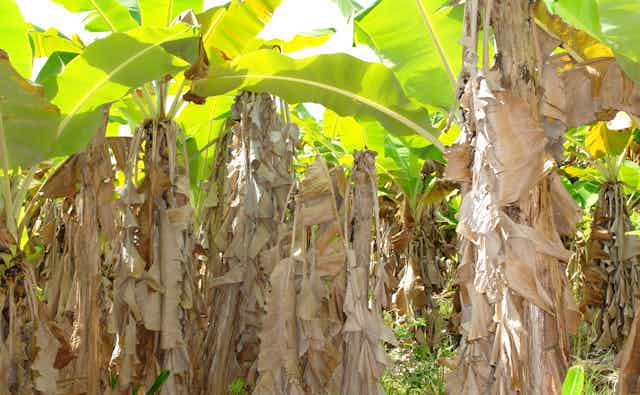Britain was once full of elm trees. But the introduction of a microscopic fungus in the 20th century changed all of that. Over the course of two epidemics, 60m elms were lost, landscapes were irreversible changed and ecosystems altered forever.
Since then, UK forests have faced an onslaught of new invasions. These include Phytophthora ramorum, a “fungus-like” organism which attacks a number of trees including larch and some species of oak, and ash dieback, a disease first discovered in the UK in 2012 which caused such alarm that the government convened Cobra, an emergency response committee usually reserved for terrorist threats and other such national emergencies.
As international trade and travel continues to increase, more plants are being shipped around the world, and more pests and diseases are showing up in unexpected places. This is a global issue, affecting agricultural crops and natural environments everywhere.
Citrus industries in the US and Brazil have suffered from a spate of exotic diseases originating from South-East Asia; in Florida “citrus canker” arrived in 1995 and US$1 billion was spent trying to eradicate it. In 2005 the towel was thrown in on the eradication program and that same year a far more devastating disease, “citrus greening”, arrived and subsequently spread throughout the state.
Bananas across the world are threatened by a strain of “Panama disease”. Wheat has been hit by a new virulent form of stem rust disease that was first discovered in Uganda in 1999, and has since spread across Africa and the Middle East.

There are many more such examples but the latest threat to Europe may be the scariest yet: a bacteria known as Xylella fastidiosa. It’s thought to have arrived accidentally on coffee plants from Costa Rica. Xylella is spread by sap-feeding insects such as spittlebugs and invades a plant’s water distribution system, preventing essential water and nutrients from being transported around the plant.
But here’s the really worrying part. Whereas many plant diseases are capable of infecting only a small number of host species, Xylella has a vast list of potential hosts plants, depending on the particular sub-species of the pathogen, such as oaks, citrus and olive trees. The EC’s emergency measures, including the removal of olive trees and other hosts, have caused public uproar and protests in the affected areas.
We need spatial data – and maps

There is some light among all this doom and gloom, however. Advances in our ability to collect data on plant diseases, and then map them out, offers up the potential to harness spatial mapping technologies and computer modelling against these invading threats.
Unlike other types of invasive species (think Japanese knotweed, say, or rats on remote islands), plant diseases are incredibly good at evading detection. These microscopic organisms can inhabit plants for weeks, months or even years before even the first signs of the visual symptoms we need to spot them.
To try and second guess where new epidemics might pop up, people are increasingly developing maps of disease risk. For example, the US Department of Agriculture combines a range of risk factors associated with different diseases. These can be meteorological drivers such as wind and rainfall, or socio-economic factors such as how connected residents in a particular community are to areas where a disease is already found. These maps can then be used to identify potential hotspots where surveillance efforts can be targeted and any new disease quickly stamped out.
As spittlebugs can carry Xylella and thus demonstrate a local tree must be infected, researchers in Italy have combined these “spy insects” and real-time data from smartphones in the field to try and detect the disease even before the plants show any symptoms.
Similar smartphone tech has been adopted in the UK project “Opal”, for instance, which has a tree health survey app that enables members of the public to identify different diseases and report them. All this information and new opportunities to detect and map outbreaks provides vital instant data on how diseases are spreading.
Plant disease map-reading
Plants don’t tell anyone when they get sick, so we have to actively search for new cases which is hard work. Better targeting of surveillance programs is incredibly important to find new epidemics and remove them before they get out of control. Together with Rothamsted Research and the US Department of Agriculture, colleagues and I at Salford are using spatial information on epidemics to help inform smart surveillance strategies.

Researchers at Cambridge University have also developed state of the art computer models of invading diseases such as ash dieback and sudden oak death. This sort of work can predict in real-time where epidemics will develop and spread, and quickly identify areas of high risk.
Plant disease epidemics represent a growing and important threat to agricultural economies, food security and natural environments. It’s clear that, with the world becoming a smaller place, opportunities for plant diseases to move around the globe are only going to increase. New ways of detecting and mapping plant disease are sorely needed from the scientific community to help combat these global emergencies.

